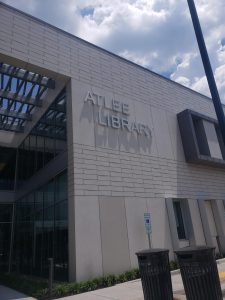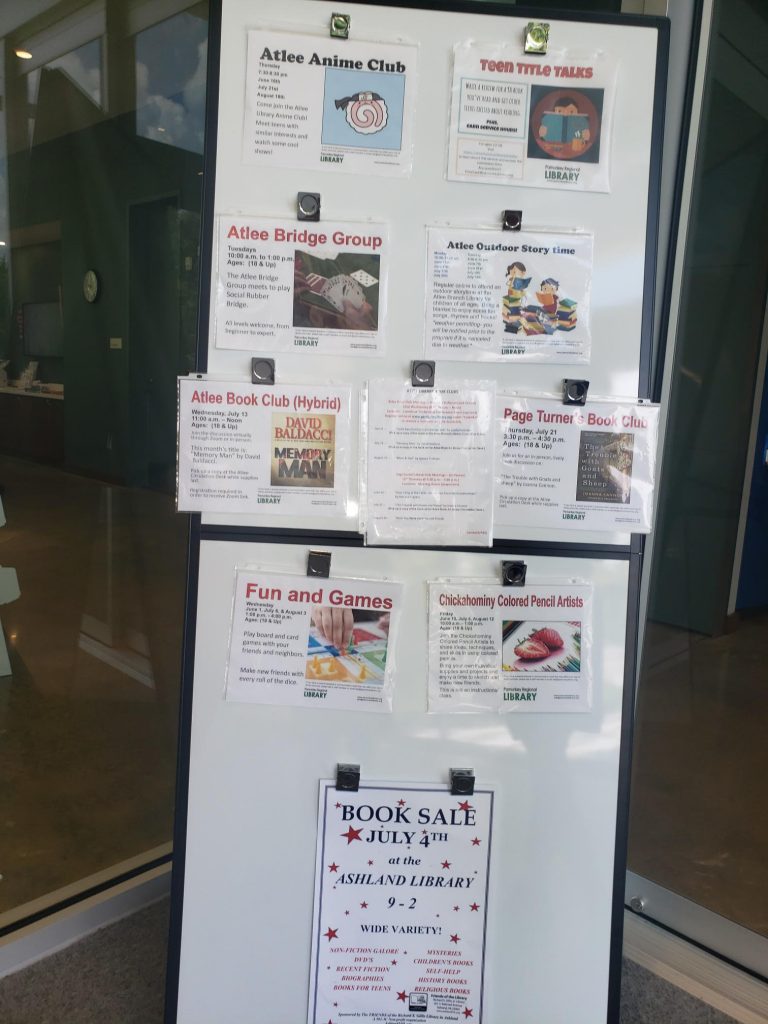Libs 608
Library visit

Today I visited the Atlee Branch Library which is part of the Pamunkey Regional Library system. Prior to visiting this branch, I took a look at their website. Overall the website is easy to navigate, with the course catalog being at the top of the website always, no matter what other links you may click. It is clear that this library serves the public in the Pamunkey region of Virginia as you can see the list of counties that it serves when you click on the “locations” tab. While their is no staff directory listed on the website, they do offer a few ways to get in contact with the staff. They have a chat now option, a general email address listed, and the phone numbers for each location listed as well. There is also easy access to their databases from their websites. They have over 20 different databases that are organized in categories such as books, careers, encyclopedias, genealogy, history, languages, newspapers, and student resources. Unfortunately, there doesn’t seem to be any accommodations available on the website. There is a button at the top that says “enable accessibility mode“, but when you click on it, nothing seems to change with the website. Other than being able to zoom in an out on the website, there doesn’t appear to be anything in place to help the visually impaired.
When I got the library, I could tell that it was recently built (research confirmed that it was built in 2020) as it still had that “new building” smell to it. It is a two story building built right off of a main road in Hanover county. It has a very clean and sharp look to it on the outside, but the inside is much more welcoming. I was able to log into the wi-fi at the parking lot. There were also book drop off boxes located in the parking lot. Inside, there is ample seating as well as many rooms labeled as “quiet study rooms” that can fit 1 or 2 people and a few conference rooms that can fit about 20 people. There is also a media room with about 20 computers in it on the 2nd floor as well as an open computer area with about 10 computers on the first floor. There is an elevator available for those who are unable to climb the stairs to the second floor. The shelving in the children’s section are all shorter to accommodate the smaller children being able to see the items on the shelves. However, in the teen and adult sections, the shelves are all higher. I personally was not able to reach items on the topmost shelf. There does seem to be enough space in hallways and between rows to accommodate wheelchairs and baby strollers. There is also one section of large print books available. However that is the only accommodation that I could find for print material. When I looked on the catalog for books in other languages, there weren’t really many options. Most books were about the language or how to learn it rather than in the language. The only exception were a few bilingual children’s books. This goes against what Rubin & Rubin say about the ALA policy that urges “libraries to ensure that their library services, facilities, and collections are accessible to all” (p.100).

Based on the fact that all material and signage were only in English, I think that this library only serves English speakers. However it is open to the public and anyone can use it, I just don’t think that a non-English speaker would feel comfortable in this library. While I was visiting, I saw a few mothers with young kids, and a few adults either browsing the books or using the computers. All of the patrons and library staff that I saw during my visit were white and appeared to be English speaking. There looked to be about 5 staff members present while I was there. There were two people at the front desk, one person as the children’s section desk, one person at the information desk, and another person who was walking around the space. I am not sure exactly what they were doing at the time, but they were easily identified as a staff member as they were wearing a library name tag.
While I was visiting, I did not notice any special collections. There was a small section of newspapers and magazines that could not be checked out, but that was it. I was unable to find any evidence of any special collections through their website either.

There were not currently any programs or events happening during my visit but there were signs posted for future events. The website also listed times for weekly story times for children.
Rubin & Rubin (2020) mention that, more than 54% of all library programing is focused on children, and another 10% involves services to youth. (p.110). I found that to be true here as well as the majority of the program and events offered were for those aged 18 and younger.
Overall, while visiting the library and its website, I felt that it was easy to navigate and find what I needed. I felt the library to be a welcoming space and felt calm and at ease while inside the building. However, I was disappointed in the lack of diversity when it comes to languages and cultures being represented as well as accommodations for those who may need them. It was also surprising to see the quantity of books at this library. It was a little underwhelming considering how big the building itself is. It seemed the meeting spaces, computer areas, and quiet rooms took up the majority of the space. However, you can easily request a book from another branch be sent to you at this branch, so I suppose that makes up for the lack of books that are physically available at that location. My biggest question would still be what exactly the librarians do at a public library as most of the staff that I observed were just sitting at the front/children’s/information desk or walking around. It would seem that there would be a lot of down time at this library for the staff. I am also unsure that anyone who is not a white English speaker would feel comfortable at this library or would see themselves represented.
Rubin, R. E., & Rubin, R. G. (2020). Foundations of library and information science (5th ed.). ALA Neal-Schuman
Leave a Reply to snaga003 Cancel reply